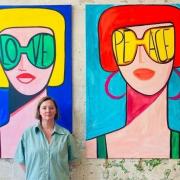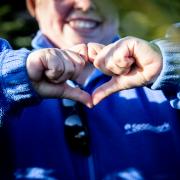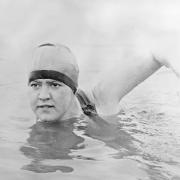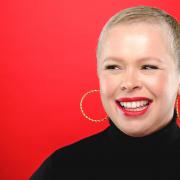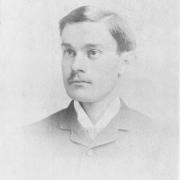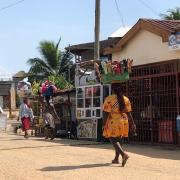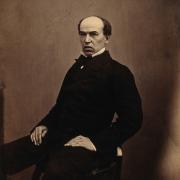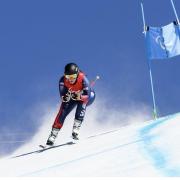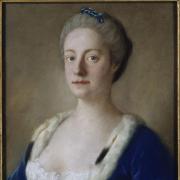Folkestone-based Dee Taylor, a fan of film noir, loves the narrative in his art, which references animations such as the Gotham City of Batman comics

In the heart of Folkestone’s Creative Quarter, Dee Taylor practices his art, in an enclosed studio in an open-plan area, with fellow artists working in their own spaces around him.
“It’s great to be able to bounce off each other,” says Dee, who has been here since 2009 when he completed a degree at the University of Kent.
“As soon as I arrived I was busy. Chris Dixon of Ashford Borough Council was at my degree show and commissioned me to make a large-scale piece for a permanent exhibition at International House, so I hit the floor running.”
Born in India, with an artistic mother, Dee was given free rein to draw on the floors and walls with coloured chalk. “The floors could be sponged off and the walls could be whitewashed, so my art was never permanent. Later, as I grew, I took to painting on every scrap of wood or card I could find.”

Art, for Dee, was always a compulsion and while his early education was at a London secondary school, he says his ‘real’ education kicked off when he started work at 15 in a London’s advertising agency, where he learnt most of what he knows today.
He eventually became an ad agency art buyer and later in his career ran a group of creative businesses in Soho and Covent Garden.
Dee thinks that the usefulness of a formal art education depends on the individual. “Natural talent and dedication will always shine through, however I do believe that a good formal education forms a well-rounded and professional attitude which is essential for a successful career.
“Having said that I do believe that life drawing, which is not considered important anymore in colleges, is invaluable for all-round visual perception,” he adds.
Dee loves oils, but generally uses acrylics, because they are so much faster. “People who are within earshot of me when I am painting will be aware of the constant sound of my hairdryer. I have learnt the tricks of the trade with acrylics and I can make the medium do what I want.”
Around the studio are numerous large canvases, witnessing Dee’s preference for large scale, however he is happy to work on all sizes, the average being roughly 70 x 60 centimetres.
“I like to work with found objects, collage, typeface and so forth within my paintings, but pure painting is a joy. The process of gradually building up a scenario, with all the layering and transparent glazing, is a process I am addicted to.”
Dee describes the genre he paints as “contemporary culture through a figurative narrative” and indeed many of his works are dark, reminiscent of animation like Batman, places like Gotham City.
He explains: “A double identity is there all the time, sometimes dark images and then also brighter images.” We look at a highly detailed and stylised glass form, from which he has made giclé prints.
These are more commercial than some of his other works and Dee is fascinating on the vicissitudes of the art market. His works, he says, appeal to a younger generation, specifically Londoners, who may have white-walled, studio-type apartments.
“These are not works that are likely to be hung over a mantelpiece,” he admits as we look at a piece with barbed wire. “This is not saleable.”
However, as he points out: “Young people love my work, which is difficult because the young often have no money.
“Making a living from art is a bit of a hit and miss affair, with periods that are very busy and I am very successful and then there may be quiet periods. What I don’t do is chase the commercial part just to sell. What is ingrained in me is film noir, I appreciate the long shadows.”
So what is the process of beginning a new project? “If it’s a commission I make notes of everything surrounding the brief. But if it’s not, it’s not the physical element, it’s the emotions, the building blocks of the work, the various elements I would need.”
We look at his vision of the Folkestone Warren. “I wanted a slightly Cubist look to it, so I started by making triangles and then the light was added, because you have to decide where the light comes from. Emotion is always a consideration and the last consideration is whether the work is commercial.”
Painting is important, he believes: “Especially in this contemporary world, where we are bombarded with digital images of all kinds. Somehow the feeling of standing before a good painting on a white wall in a good gallery conveys us away from the kaleidoscopic chaos that whirls about us. I thank painting for this respite.”
Get in touch
Dee Taylor at 35/37 Gallery, Tontine Street, Folkestone, CT20 1JT,
Studio visits by appointment, call 0794 9833153 or email deetayl@tiscali.co.uk
Dee Taylor will be exhibiting at the Bauhaus Café and Art Gallery, Creative Collective Ashford, 2 North Street, Ashford TN24 8JN, 01233 421589 with a private view on 9 March from 6-8 pm and from 1 to 12 March.




